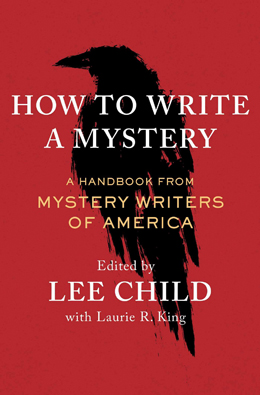One of the buzziest anthologies of the year is How to Write a Mystery from the Mystery Writers of America, edited by Lee Child with Laurie R. King. The cover calls this work a handbook and that is the perfect way to describe this now-invaluable resource. The book is less of a “how to” – although there are certainly elements of that throughout – but more of a frame(work) through which to view the mystery genre.
After a brief, but inspiring, introduction from Lee Child, the first section of the collection deals with the various sub-genres that make up the kaleidoscope that is Crime Fiction. So for example, you have Meg Gardiner providing nine tips that will make a thriller stronger, Rachel Howzell Hall ruminating on the Police Procedural, and newly-awarded MWA Grand Master Charlaine Harris talking about blending other genres into your mystery. The anthology’s editors have done an excellent job of ensuring that all avenues of this wide category are acknowledged – something that is sometimes not taken into consideration. So here there are essays on the amateur sleuth (Naomi Hirahara), darker noir (Alex Segura), historicals (Jacqueline Winspear), medical thrillers (Tess Gerritsen), and spy novels (Gayle Lynds). There is a minor misstep in not including anything on the domestic or psychological suspense arena, but that can be covered in volume two. Neil Nyren starts this section with an important essay on “Rules” and the power of knowing what they are and when to ignore them.
The next section of the collection drills down even further and provides a look at mysteries for young readers of various ages (Susan Vaught, Chris Grabenstein, and Kelley Armstrong), graphic novels (Dale W. Berry and Gary Phillips), short stories (Art Taylor), and Daniel Stashower on True Crime.

One can think of these early sections as the foundation onto which all else will be built. With so many possible ways to tell a crime story, these authors go a long way towards providing enough guidance without imposing limitations. From here, the collection moves on the nuts and bolts of writing itself.
Here Lyndsay Faye does an excellent job of talking about the elusive and intangible topic of “voice.” This is followed by a pair of essays by Jeffery Deaver and Lee Child debating the merits (or not) of outlining your work. Laurie R. King extols the value of rewriting in her beautifully crafted essay.
This leads to a look at some of the more central elements needed for all stories – Plot (Deborah Crombie), Protagonist (Allison Brennan), Antagonist (T. Jefferson Parker), Supporting Players (Craig Johnson), and Setting (William Kent Kruger). Greg Herren contributes a great essay on dialogue and how its authenticity adds depth to each character on the page. Adding Humor (Catriona McPherson) and Diversity (Frankie Y. Bailey) are also discussed with respective essays in this section. For writers looking to partner up, Caroline and Charles Todd provide invaluable information about working with others, while Max Allan Collins treads into the area of writing about characters created by others.
The last section of the anthology looks at what happens after the writing is done. As a critic, I was most interested in Oline H. Cogdill’s essay on reviewing. I was not disappointed. In this short piece, Oline provides important advice for both other reviewers and for those who are being reviewed. Liliana Hart writes about the complex world of self-publishing, Daniel Steven provides a overview of the infinitely complex topic of legal matters for authors, and Maddee James encourages with some guidance on building an audience and author identity online. One of my favorite essays in the collection comes from Louise Penny talking about growing your community and I can’t think of an author who better exemplifies this important and too-often overlooked aspect of a writing career.
Much has been said in the last few years about the need for the crime fiction community to add diversity to its ranks. This has never been clearer than when looking at the table of contents of many anthologies – there are so many that contain *no* diversity at all. So, Lee Child and Laurie R. King should be proud to have organized a collection such as this, which features authors and topics that reflect the vast scope of this community’s members and contributions. How to Write a Mystery is sure to be an important reference book for many years to come.
BUY LINKS: How to Write a Mystery

Great review! Thanks for this. (And pleased to be part of the collection myself, of course!)
A wonderful review. Just bought my copy from my indie bookstore and signed by Oline! I can’t wait to dig into the book!
Thanks for the thorough review. This anthology is my next purchase. I’m excited to see so many great topics.